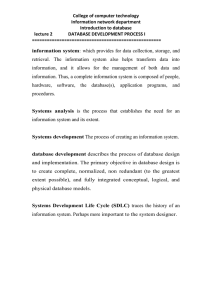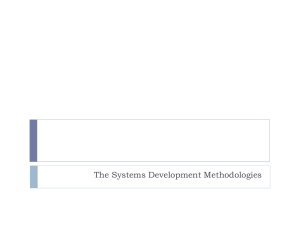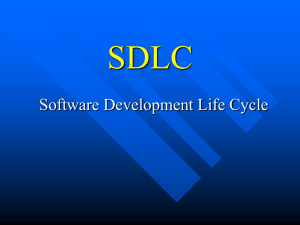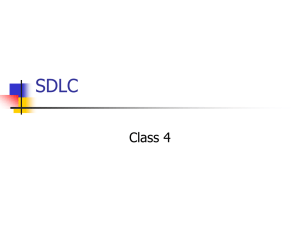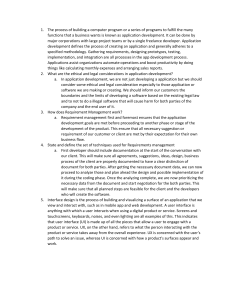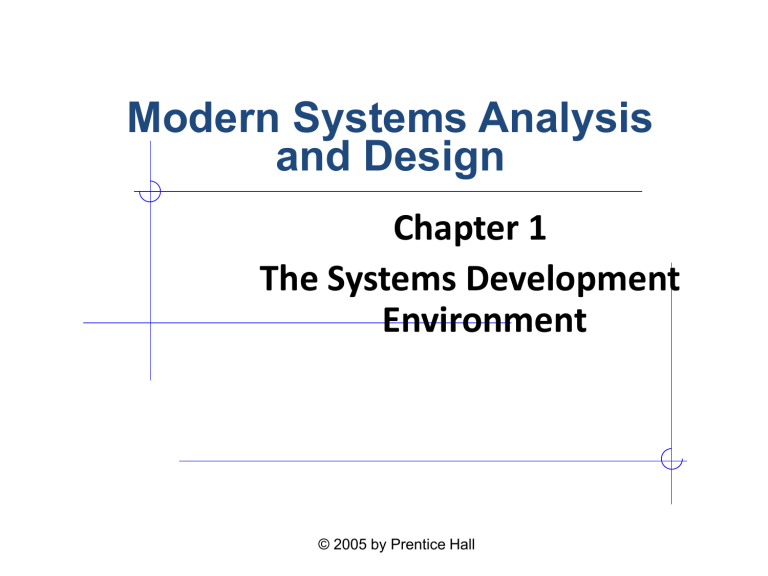
Modern Systems Analysis and Design Chapter 1 The Systems Development Environment © 2005 by Prentice Hall Learning Objectives Define information systems analysis and design. Describe the different types of information systems. Describe the information Systems Development Life Cycle (SDLC). Explain Rapid Application Development (RAD), prototyping, Joint Application Development (JAD), and Computer Aided Software Engineering (CASE). 1-2 Introduction • Information Systems Analysis and Design – Complex organizational process whereby computer-based information systems are developed and maintained • Application Software – Computer software designed to support organizational functions or processes • Systems Analyst – Organizational role most responsible for analysis and design of information systems 1-3 Introduction (cont.) 1-4 Types of Information Systems and Systems Development • Transaction Processing Systems (TPS) – Automate handling of data about business activities (transactions) – Process orientation • Management Information Systems (MIS) – Converts raw data from transaction processing system into meaningful form – Data orientation • Decision Support Systems (DSS) – – – – 1-5 Designed to help decision makers Provides interactive environment for decision making Involves data warehouses, executive information systems (EIS) Database, model base, user dialogue Types of Information Systems and Systems Development (cont.) 1-6 Developing Information Systems and the SDLC • System Development Methodology – Standard process followed in an organization – Consists of: • • • • 1-7 Analysis Design Implementation Maintenance Systems Development Life Cycle (SDLC) • Traditional methodology for developing, maintaining, and replacing information systems • Phases in SDLC: – – – – – 1-8 Planning Analysis Design Implementation Maintenance Standard and Evolutionary Views of SDLC 1-9 SDLC Planning Phase Identify, analyze, prioritize, and arrange IS needs 1-10 SDLC Analysis Phase Study and structure system requirements 1-11 SDLC Design Phase Convert recommended solution to system specifications Logical design: functional features described independently of computer platform Physical design: logical specifications transformed to technologyspecific details 1-12 SDLC Implementation Phase Code, test, install, and support the information system 1-13 SDLC Maintenance Phase Systematically repair and improve the information system 1-14 1-15 The Heart of the Systems Development Process 1-16 Current practice combines analysis, design, and implementation into a single iterative and parallel process of activities Traditional Waterfall SDLC One phase begins when another completes, little backtracking and looping 1-17 Problems with Waterfall Approach • System requirements “locked in” after being determined (can't change) • Limited user involvement (only in requirements phase) • Too much focus on milestone deadlines of SDLC phases to the detriment of sound development practices 1-18 Alternatives to Traditional Waterfall SDLC • • • • Prototyping CASE tools Joint Application Design (JAD) Rapid Application Development (RAD) 1-19 Prototyping Iterative development process: Requirements quickly converted to a working system System is continually revised Close collaboration between users and analysts 1-20 CASE Tools • Computer-Aided Software Engineering • Software tools providing automated support for systems development • Project dictionary/workbook: system description and specifications • Diagramming tools • Example products: Oracle Designer, Rational Rose 1-21 Joint Application Design (JAD) • Structured process involving users, analysts, and managers • Several-day intensive workgroup sessions • Purpose: to specify or review system requirements 1-22 Rapid Application Development (RAD) • Methodology to decrease design and implementation time • Involves: prototyping, JAD, CASE tools, and code generators 1-23 Object-Oriented Analysis and Design • Based on objects rather than data or processes • Object: a structure encapsulating attributes and behaviors of a real-world entity • Object class: a logical grouping of objects sharing the same attributes and behaviors • Inheritance: hierarchical arrangement of classes enable subclasses to inherit properties of superclasses 1-24 Summary • In this chapter you learned how to: Define information systems analysis and design. Describe the different types of information systems. Describe the information Systems Development Life Cycle (SDLC). Explain Rapid Application Development (RAD), prototyping, Joint Application Development (JAD), and Computer Aided Software Engineering (CASE). Explain Object Oriented Analysis and Design and the Rational Unified Process (RUP). 1-25
